
Is the “new” Poseidon’s Fury better than the old? In many quantifiable ways, the answer is yes. Guest satisfaction with the attraction improved on polling and surveys, so in that way, the impossible task of reimagining an attraction in 12 weeks succeeded. And remember those hard-and-fast limitations (one live actor; a “story” room; an Oracle Chamber; a Vortex; a special effects finale; a “teleportation” effect)? Did Gary Goddard and his team manage to use what they were given to solve the issues guests had with Poseidon’s Fury? It seems that way…
But pre-Twitter, online theme park discussion boards were alight with fans’ mixed reactions to the changes. Why replace the Keeper with Taylor? Why turn Poseidon into the hero, and opposite a made-up villain? Why recast the show’s teleportion effect and thereby “ruin” its grand finale? We’re lucky that Gary Goddard himself responded to criticisms of his version of the show on a fan message board. Reading his defenses to nostalgic fans is enlighting, but we’ll summarize the big questions (and his answers) here:
1. Why replace the Keeper with Taylor?
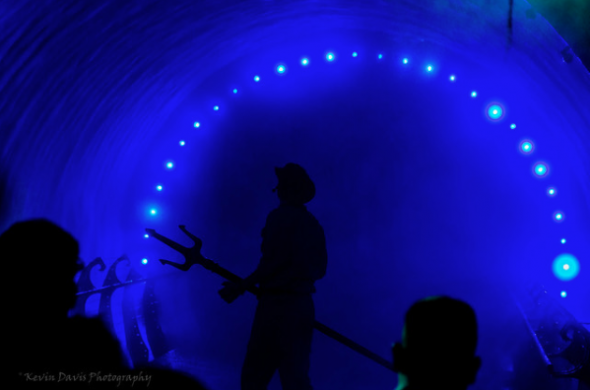
The switch from an old man to a young archaeologist was a smart one. Narratively, it grounds our experience in a particular time (1930s, circa Indiana Jones) and provides us with someone we can relate to; someone uncovering the story along with us, speaking aloud our experience and making the journey more personal.
Operationally, it allows male and female Team Members to take on the role. Like a Jungle Cruise Skipper, the specific reactions and delivery of your “Taylor” may vary, but he or she is at the very least a better guide through the temple and a better establishing character for the attraction’s tone than the Keeper.
Taylor, the Global Discovery Group, and the new “excavation” set pieces also brilliantly solve the show’s lighting problem (now, archaeological lamps and flashlights can reveal murals and secret messages) and provide guests the motivation or role that the former version lacked. Why are we here in this temple? Because it’s a recent discovery, and we’re globe-trotting adventurers who’ve come here for a tour! The attraction isn’t happening around us; it’s happening to us, and to Taylor!
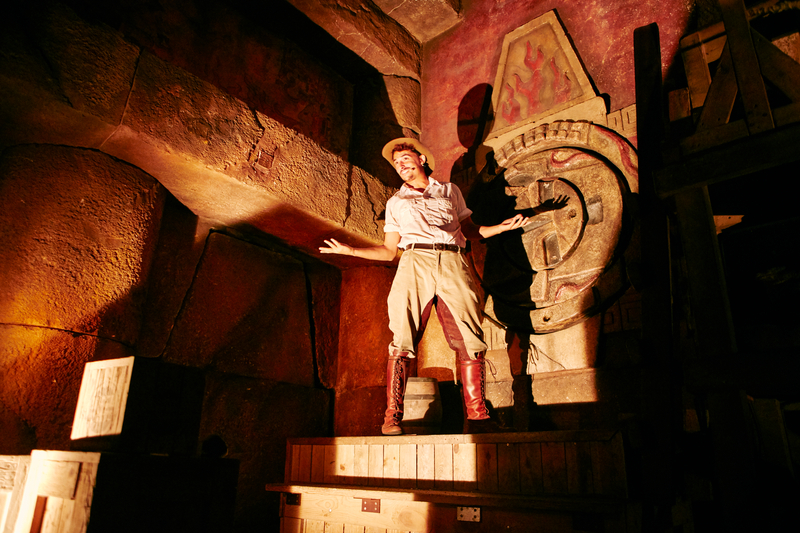
(Perhaps not-so-coincidentally, the opening of the “new” Poseidon’s Fury in 2001 lines up with the 2001 opening of a similar attraction at Spain’s PortAventura – a park owned by Universal from 1998 to 2004. There, Templo del Fuego is the fiery antithesis to Poseidon’s watery show, and the installation in Spain uses a similar archaeological set-up, characters, and effects.)
2. Why turn Poseidon into the hero and pit him against Lord Darkennon?
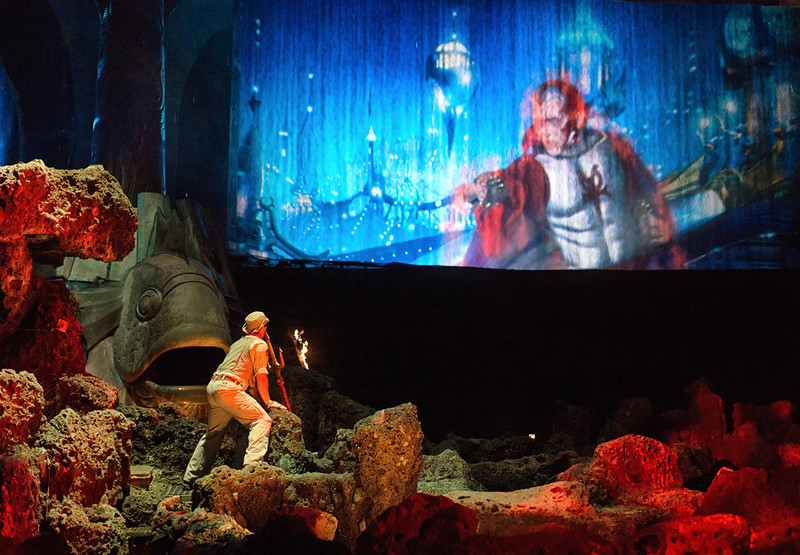
While neither story is in any way true to mythology, Goddard argued that in the original, Poseidon wasn’t really evil or intimidating, but more of a ‘Disney villain’ – annoyed and snippy. As a result, guests never faced any “real,” compelling danger. The idea of a jealous high priest slaughtering humans to gain godlike power makes Darkenon more overtly, introvertibly evil and a more real threat to us, the audience.
And where the original version of the attraction basically spent the first two chambers with the Keeper trying to explain the convoluted story without much happening (remember, we didn’t officially meet or even hear from our hero or villain until their final battle), the new “threat” of Darkenon sets up action in each room; from the haunting spell and his awakening in the first to his attempts to kill us in the second, making his defeat in the third much more rewarding.
3. Why reverse the “teleportation” effect?

Perhaps the biggest complaint leveled against the “new” Poseidon’s Fury is that it intentionally reversed the attraction’s final effect. (Park Lore supporting Members can view a gallery of illustrations of the effect’s inner workings above.) Whereas the original saw guests pass through the Vortex and into the cavernous underwater world to be “transported back” at the show’s conclusion, the “new” show has guests pass through the Vortex and… into a room that looks nearly identical to the one they just left.
While it’s easy to complain about the change, Goddard’s answer here, too, is enlightening. In the original, guests entered the massive Chamber under load lighting, with time to look around and see the lighting rigs, exit signs, fountains, and industrial hardware needed to run the show while a rising bubble “screensaver” made the five film screens ahead easily identifiable… a sort of illusion-shattering pause in the action while guests simply… wait. Then, exactly as expected, once guests were in place the “show” would begin.
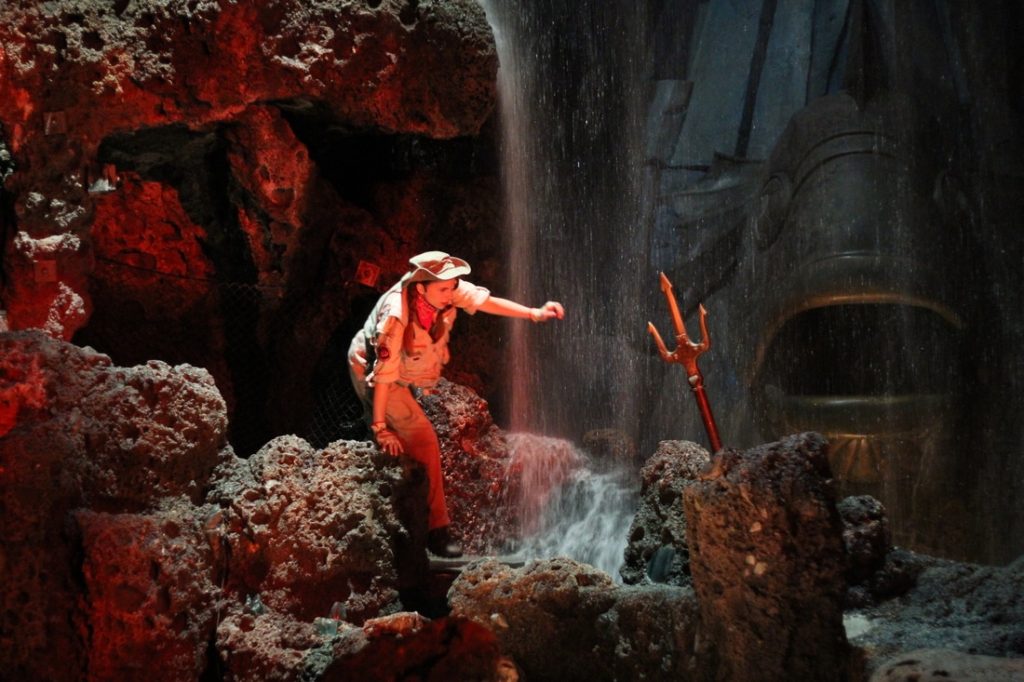
Now, guests enter into a smaller chamber that – by nature of being a duplicate of the old version’s second room – looks not exactly like the room they just left, but like yet another small, undiscovered chamber blocked by another gate they can’t open. It’s this room that contains guests during the lagging load time, with the massive chamber being revealed only under show lighting as designed (with the clever reveal of an octopus swimming away from the windows being a spectacular reveal as light from the underwater world comes pouring in).
Sure, one could argue that original sequencing of the transportation effect admirably “saved the best for last” in terms of the show’s special effects, and perhaps it’s less magical to lose the overt connection of suddenly being back in a room you were previously in; but in exchange, the reveal of the larger chamber is instead much more effective and grand. Two steps forward, two steps back? We’ll let you decide.
4. Why switch the animated Zeus and Poseidon for live actors?
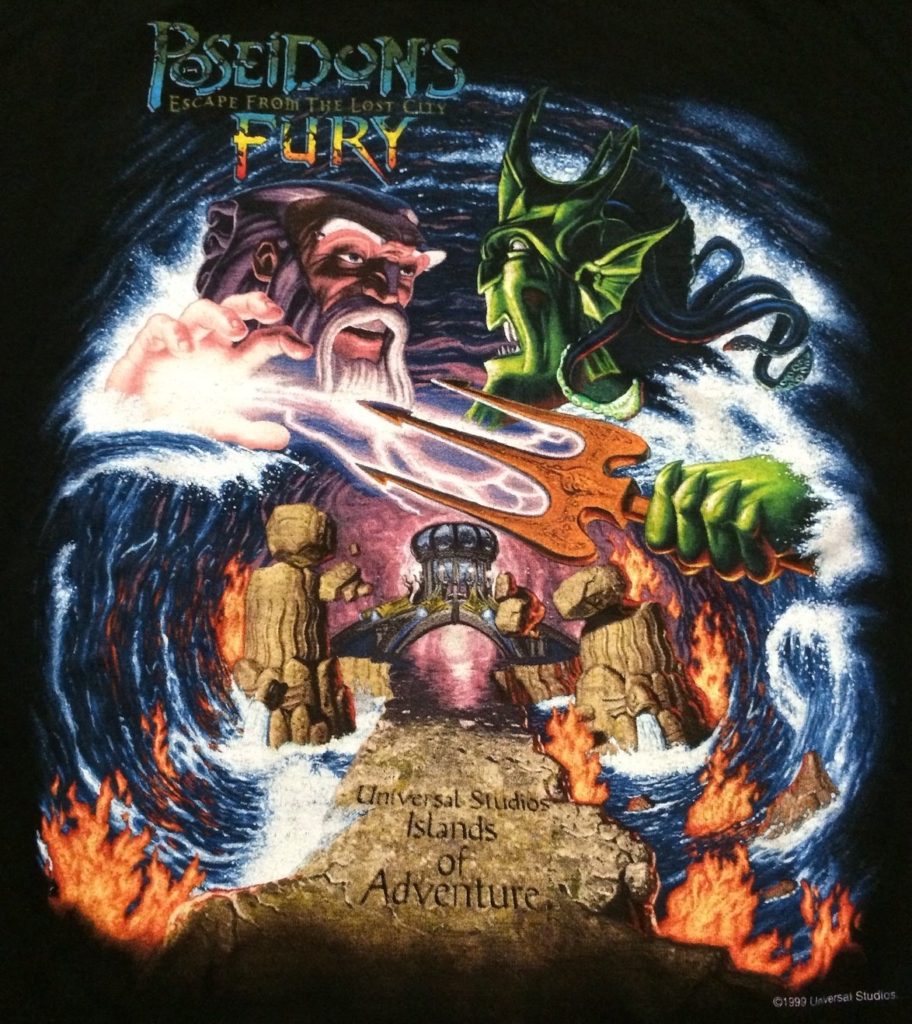
Goddard’s answer here is that, frankly, it seemed incongruous that our live guide – the Keeper – would transform into a (1997-quality) CGI character anyway, and that it removed any realism (and any “threat”) earned by the twenty minutes preceding to have our evil villain finally embodied as a cartoon merman.
He’s right, but… admittedly, today’s finale, too, feels unreal, with actors in silly Latex costumes hastily filmed in front of a green screen and superimposed over the old CGI background, with uncomfortable moments when they “reach” past the projectable screen or clash in slow-motion Renaissance Fair duels. Through its use of animation and stylization, the former version’s finale was arguably more visually compelling, while the new ending – ironically – feels somewhat silly. And because it must take place as fire effects rage, it lacks the blackness that made the former so colorful and theatrical.
In other words, this is one area where a reimagining today would probably split the difference. There was definitely something compelling and creative about having Poseidon and Zeus realized as “original” and highly stylized characters (perfect for action figures, plush, and t-shirts!) that live actors in superhero-style suits misses.
Reflections
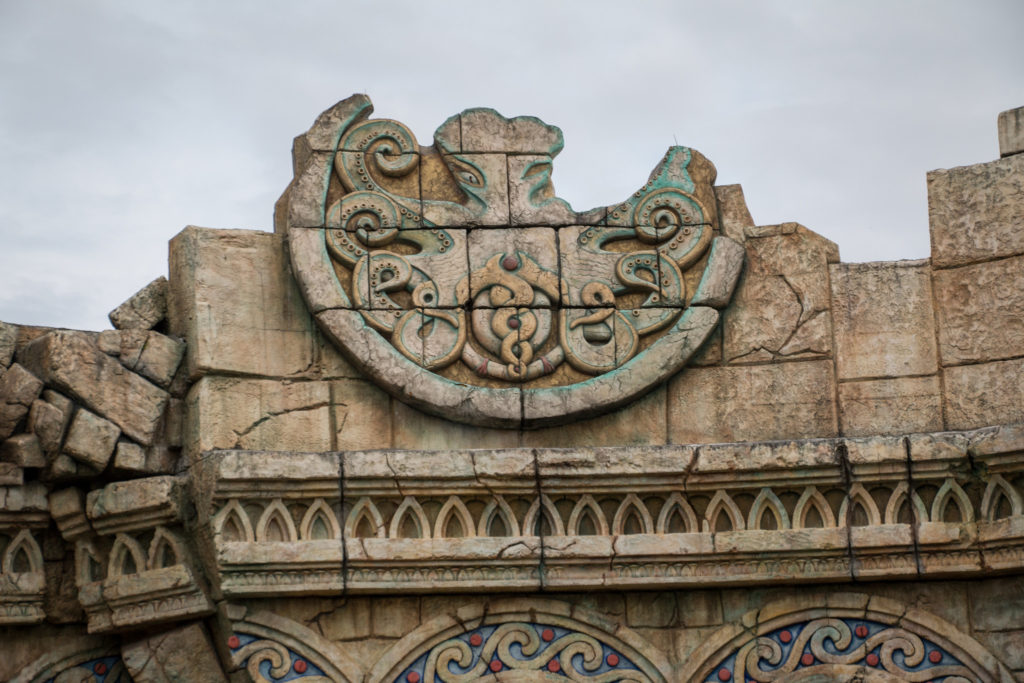
Still, there’s little doubt that – considering its limiting factors, low-cost, and incredibly condensed design timeline – the “reimagined” version of Poseidon’s Fury is a triumph. Goddard and company used what they were given to create a compelling, exciting attraction. It’s unabashedly absurd and hilariously fun; “so bad it’s good;” a cult classic that’s unironically beloved by thousands of themed entertainment design enthusiasts. Touring Plans hit the nail on the head by naming it one of the “Best Worst Attractions.”
But undeniably, it’s also… a Band-aid. It’s likely that even Goddard himself imagined his quick-fix rewrite as a stopgap – not a permanent fix that would still be playing two decades later without a properly-budgeted overhaul. Likewise, Universal’s then-Vice President of Attraction Design, Phil Hemetta, reflected on the development of Islands of Adventure with Theme Park Tribune in 2019, citing Poseidon’s Fury as a piece of the park he wishes he could revisit.
“I think Poseidon’s Fury had the potential to be a really, really breakthrough attraction, and it came right up to it, but didn’t quite cross that threshold. Through several revisions, it still never really caught fire. I lamented that because I thought, and I still believe, there was a big concept there. I could go on for hours about why I think that never really happened, and it was those kind of lessons as a designer you carry with you for the rest of your life. Because it’s so heartbreaking, to know in your heart that something could be so good – and not due to lack of trying on everyone’s part, but the pieces don’t come together.”
All things considered, it’s really no surprise that even the “new” version of the show feels perpetually endangered, and has faced a number of “Sink or Swim” moments…
Sink or swim…?
First, things looked grim when the Vortex was turned off from 2008 to 2010 (purportedly as part of NBC’s “Green is Universal” eco-initiative… though almost certainly just a budget-saving move during the 2008 recession and its ensuing tourism downturn). Obviously, Poseidon’s Fury without its signature effect is like a meet and greet ending in an empty room, thus yielding two years of online assurances that the attraction’s closure was imminent.
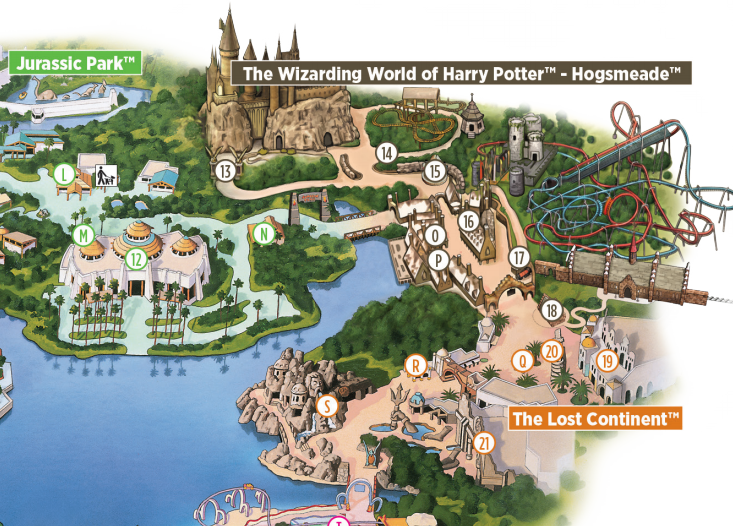
Bolstering those rumors was the 2009 announcement that the Wizarding World of Harry Potter would soon move in, overtaking the Lost Continent. Undeniably, it made a lot of sense to sacrifice the attraction to a blockbuster expansion like Potter was certain to be… But as it turned out, Hogsmeade really replaced only the Merlinwood section of the Lost Continent, salvaging Sinbad’s Bazaar and the Lost City, leaving Poseidon’s Fury to live another day.
But in 2011, after Hogsmeade’s astounding debut (increasing Islands of Adventure’s attendance by an unfathomable 36% the year prior), rumors began to swirl that an expansion of the Wizarding World was inevitable… and exceedingly likely to devour what was left of the Lost Continent. And of course, The Wizarding World of Harry Potter – Diagon Alley did open in 2014… but at the original Universal Studios Florida park, connected to Islands of Adventure’s Hogsmeade by way of the clever, inter-park Hogwarts Express train. Phew.

In September 2018, the only other remaining inhabitant of the Lost Continent – “The Eighth Voyage of Sinbad” stunt show – closed after a two decade run. That left Poseidon’s Fury as the only attraction in the land (and for that matter, the last original, IP-free attraction in the entire resort). Almost certainly, that meant that the remainder of the Lost Continent was prime real estate for expansion, with rumors of a Zelda land born of Universal’s partnership with Nintendo spreading like wildfire.
But against all odds and expectations, Poseidon’s Fury survived.
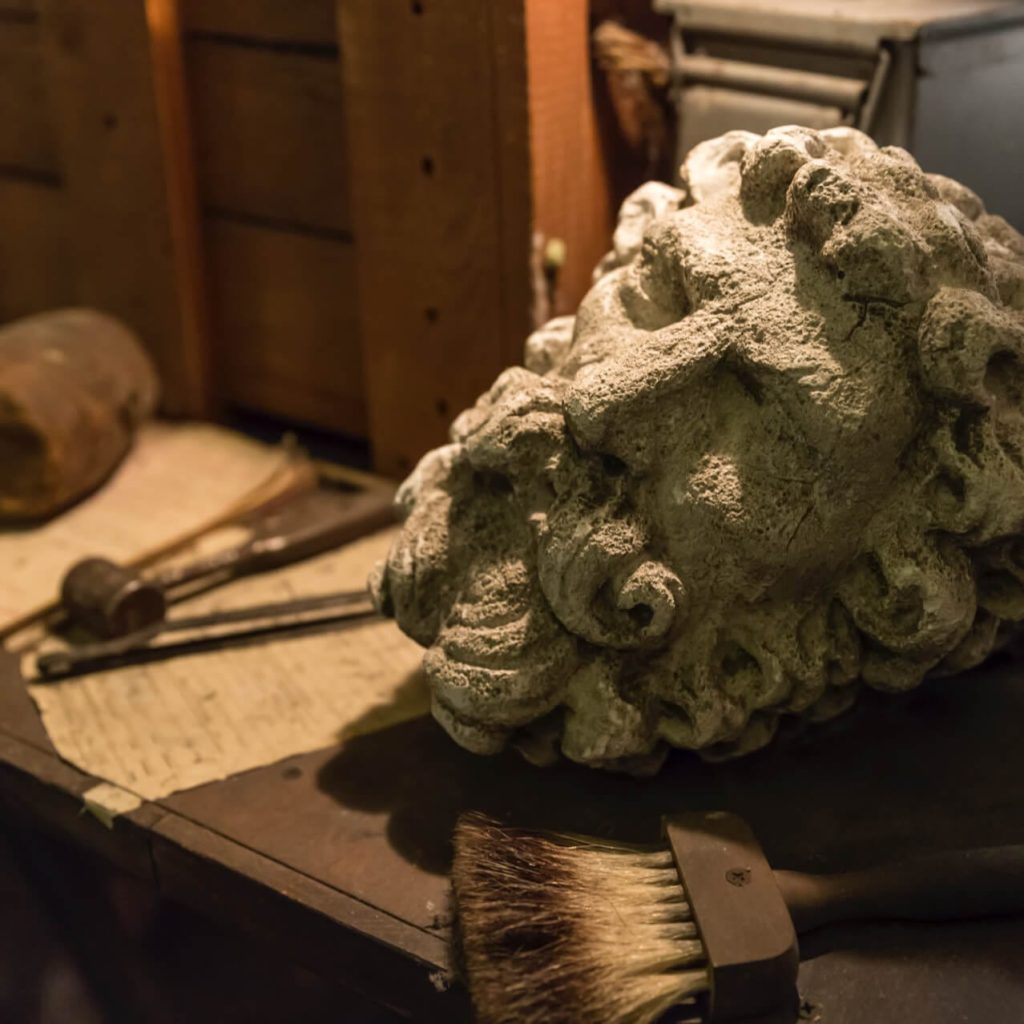
Then came 2020. After an unprecedented three-month closure due to the global COVID-19 pandemic, Universal Orlando re-opened fully in June 2020. But it quickly became apparent that the resulting global tourism downturn would last, and the parks needed to scale back operations again. On August 9, 2020, several attractions across the resort were temporarily closed, and given Poseidon’s Fury’s indoor, close-quarters, Team-intensive status, it wasn’t much of a surprise that it was included on the list. But then, over the next year, each affected attraction re-opened one-by-one… except Poseidon’s Fury.
This, fans suspected, really was the end. The pandemic must’ve simply given Universal the excuse it needed to shutter the long-running show and move on, leveling the Lost Continent for Zelda or Tomb Raider or God of War or Lord of the Rings or whatever property they would license next…
Even once extensive facade work overtook the temple’s exterior in October 2021, some Internet commentators doubted Poseidon’s Fury would actually return… But on March 14, 2022 – 17 months after its post-COVID closure – it did. Against all odds, Poseidon’s Fury was unsealed, with its 2001 “quick fix” story and footage unchanged.
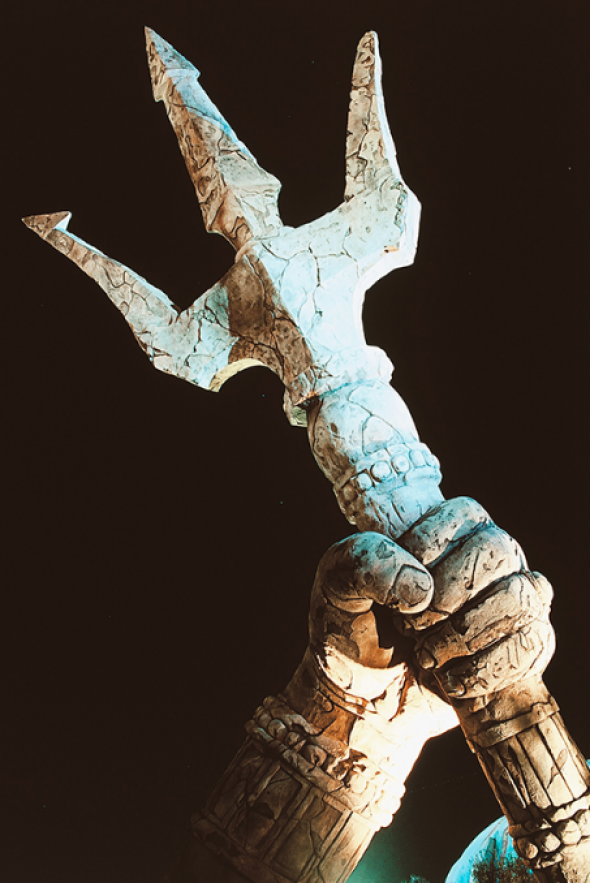
Poseidon’s Fury is survivor; a can’t-miss cult classic of themed entertainment design; “so bad it’s good”; a joyful, outrageous, original, mythical mess. Against all odds, the legendary descent into the oceanic ruins remains, packed with effects and magic and lore and mystery. It’s unapologetically over-the-top; a wild, bold, and original creation; a one-of-a-kind, last-of-its-kind experiment.
Most importantly, it’s something different. For that reason alone, we should hope Poseidon’s Fury is never quelled.
We want to hear your thoughts. What parts of the original production should’ve been kept, and why? In your opinion, does the 2001 rewrite save the attraction, or sink it? What pieces of the story of Poseidon’s Fury should act as a cautionary tale for attraction designers today? Do you think the failure of Poseidon’s Fury might’ve turned Universal off from epic, original character attractions for good? What does the future hold for this unusual would-be headliner?

Thank you so much for reading. Now, it’s your turn to join the story. If you enjoy spending time falling down the “rabbit hole” of Park Lore’s in-depth, ad-free, member-supported stories, consider becoming a Member for as little as $2 / month.
Members can unlock rare concept art in every tale, reveal attraction audio streams in select stories, gain access to over a hundred exclusive articles in our quick-read Extra Features and in-depth Special Features collections, gain exclusive podcast extras, and receive an annual member card and merch in the mail! (Plus, y’know, supporting research-based, ad-free, clickbait-free, in-depth theme park writing!)
And remember – you can dive deep into countless stories on beloved Lost Legends, uncovered Declassified Disasters, and never-built Possibilitylands.



I definitely agree with some of your points and not so much with others. Saying someone is “alleged [blank]” can ruin their life. But if they are exonerated, there’s never a headline about that. As the writer you absolutely have the choice to mention it. Regardless, thank you for your thoughtful response and I do not wish for this to distract from the great journalistic work here.
You mention that “in fairness” you should mention assault allegations against the creator. But it seems that “in fairness” allegations wouldn’t be mentioned at all.
I wouldn’t typically approve – much less respond – to a comment so far afield of the attraction or memories associated with it, but in this case, I figured I should.
I suppose it depends on whom you intend to be fair to. Yes, allegations are just allegations. But as a writer and storyteller, it’s important to me that we acknowledge those claims for several reasons.
For one, here at Park Lore, we believe people when they report being victims of sexual assault or abuse. Believing victims does not mean that alleged crimes shouldn’t be investigated or that the alleged perpetrator is guilty. With that said, it would be unfair to those who reported this alleged abuse – and indeed, any reader who’s been assaulted or abused – to simply “not mention” it. I guess I’m “woke” like that.
Second – and as an extreme example – Bill Cosby legally has no convictions for his alleged crimes; Jeffrey Epstein is unconvicted in his 2019 case; OJ Simpson wasn’t convicted in 1994. But of course, just “not mentioning” that “in fairness” to any one of them would be an outrageous oversight and journalistic omission in any sort of discussion of that entertainer’s life, work, and legacy. It’s not even “political” or taking a “position” on a hot button issue; it’s part of telling the complete story.
Finally, as a storyteller who generally prides himself on contextualizing the “bigger picture” of the industry and the creators who work on these attractions, it’s important to me that we’re able to intellectually and emotionally differentiate the works of art we love from the often flawed humans who bring it to life. As a tremendously pivotal figure in many attractions that have shaped me, I can’t not talk about Gary Goddard and his impact on the industry I love. But any story here that celebrates his ideas shouldn’t read like a deification or veneration of him as a person. Contextualizing the role of Goddard and his contributions requires acknowledging allegations that – “fair” or “unfair” – are a part of his story.
You (hopefully) came here for “in-depth, interconnected, and inclusive” theme park storytelling. That’s what I promised, and this is how I do it.